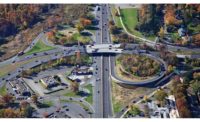With a $215-million budget, the rehabilitation of a two-mile stretch of Route 18 in New Brunswick, N.J., was the largest project in the history of the N.J. Department of Transportation when it broke ground in March 2005. One of the state’s most congested corridors, the route saw 85,000 motorists daily and is a critical connection to Rutgers University, the world headquarters of Johnson & Johnson, three major hospitals and the New Brunswick Station rail lines.

Given the project’s complexity and impact on the local community, team members carried out extensive coordination and communication efforts with local stakeholders.
“We did more than reach out to the local community; we involved them,” says Michael Morgan, project manager at engineering firm Gannett Fleming.
The team implemented an intensive “Context Sensitive Solution” approach that included regular community partnering meetings with a team comprised of crucial project-area stakeholders, as well as information centers opened to the general public, incorporating community input into the design. Quarterly partnering meetings continued during construction to discuss project issues.
The project required the demolition, construction or rehabilitation of six bridges, as well as the development of local and express lanes of traffic requiring 25 retaining wall structures. To help fast-track the schedule, Gannett Fleming worked with general contractor, The Conti Group of Edison, N.J., to re-sequence the project from eight phases to five.
At peak, the project, which completed in March 2010, had 14 concurrent subcontractors and 200 crewmembers from The Conti Group working in 15 different locations around the clock. Throughout the project’s duration, 14 major traffic shifts were required.
Patrick Hogan, chief operating officer at The Conti Group, says the team used intense preconstruction planning to meet or beat the schedule and minimize the impact on the community.
We put all of the time and effort up front,” he said. “We turned every rock over to see what we could find, so that once we demoed a bridge, we could take it down and put the replacement right up.”
The centerpiece of the project is a 593-ft-long 61-ft-high precast concrete barrel arch bridge that is the largest of its kind in North America. The bridge features eight arch barrels, each with a span of 66 ft and a rise of 20 ft. A total of 16 precast pieces were needed per barrel. The bridge’s precast concrete spandrel panels were cast with formliners simulating a cut-stone masonry finish.
The Conti Group devised an innovative installation technique for the bridge’s segmental precast units. Each arch consisted of two 33-ton half arches, a “male” and “female” section that formed each barrel. Temporary hydraulic structures were used to brace the first arch segments until the forces were balanced out enough that the bracing could be removed. Using this method, all bays were set within three weeks.
Key Players
Developer/Owner: New Jersey Department of Transportation
Engineer of Record: Gannett Fleming, Camp Hill, Pa.
General Contractor: The Conti Group, Edison, N.J.*
Construction Manager: Greenman Pedersen, Inc., Babylon, N.Y.
Landscape Architect/Urban Design: Stantec, New York
*Project Submitted by The Conti Group and Gannett Fleming, Camp Hill, Penn.



Post a comment to this article
Report Abusive Comment